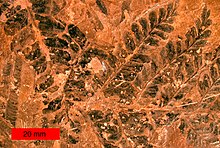| Calamopityaceae Temporal range:
| |
|---|---|

| |
| Scientific classification | |
| Kingdom: | Plantae |
| Clade: | Tracheophytes |
| Division: | †Pteridospermatophyta |
| Order: | †Calamopityales Němejc, 1963 |
| Family: | †Calamopityaceae Solms, 1896 |
| Synonyms | |
| |
Calamopityaceae is the largest family of the division of extinct seed-bearing plants (spermatophytes) known as Pteridospermatophyta.[1][2] It is the only family in the monotypic order Calamopityales.[3] This family is characterized by its petioles and specific wood pattern, and it grew only in the Paleozoic era, specifically in North America and Europe.[1][4][5] Three form genera within the family are diagnosed by their stem structure: Calamopitys, Stenomyelon, and Diichinia.[1] It was named by Solms-Laubach in 1896. Since then, its genera have been added to and grouped differently.[1]
- ^ a b c d K., Sinha, A.; Kumar., Anil (2006-01-01). Botany for degree students : Gymnosperms. S Chand. ISBN 9788121926188. OCLC 857708675.
{{cite book}}: CS1 maint: multiple names: authors list (link) - ^ Singh, V. P. (2006-01-01). Gymnosperm (naked seeds plant) : structure and development. Sarup & Sons. ISBN 9788176256711.
- ^ Taylor, Edith L.; Taylor, Thomas N.; Krings, Michael (2009). Paleobotany: The Biology and Evolution of Fossil Plants. Academic Press. pp. 271–74. ISBN 9780080557830.
- ^ Hotton, Carol; Stein, William (1994-03-01). "An Ontogenetic Model for the Mississippian Seed Plant Family Calamopityaceae". International Journal of Plant Sciences. 155 (2): 119–142. doi:10.1086/297152. JSTOR 2995557. S2CID 85151157.
- ^ Taylor, Edith; Taylor, Thomas; Krings, Michael (2009). Paleobotany: The Biology and Evolution of Fossil Plants (2). Academic Press. ISBN 9780123739728.